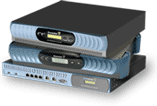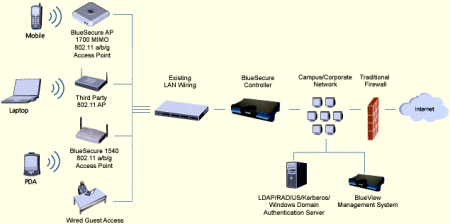MIMO-enabled enterprise access point runs Linux
Jun 12, 2007 — by LinuxDevices Staff — from the LinuxDevices Archive — 1 views Bluesocket used Linux in what it claims to be the first enterprise-class wireless access point based on MIMO (multiple-input, multiple output) technology. The BSAP-1700 runs the Network Equipment version of Wind River Linux, and works with Bluesocket's “BlueSecure” controller devices, also based on Wind River… Linux.
Bluesocket used Linux in what it claims to be the first enterprise-class wireless access point based on MIMO (multiple-input, multiple output) technology. The BSAP-1700 runs the Network Equipment version of Wind River Linux, and works with Bluesocket's “BlueSecure” controller devices, also based on Wind River… Linux.
MIMO is the key technology behind 802.11n, a recently approved IEEE standard designed to increase the throughput and range of wireless networking devices. Wireless devices based on MIMO have multiple radio transceivers and antennas, enabling them to multiplex traffic across available frequencies, increasing spectrum utilization and routing around interference.
The BSAP-1700 is an indoor access point with six internal 802.11a and 802.11b/g antennas. It is based on a 400MHz Broadcom (formerly SiByte) BCM1122, which features a MIPS64 core, along with a DDR memory controller, high-speed packet interface, and on-chip PCI and ZBbus buses.
Bluesocket said the BSAP-1700 monitors the RF spectrum for noise, interference, and coverage holes, dynamically adjusting power and channel settings to maintain maximum availability. The device also balances clients across available access points, detects rogue access points, and provides fast roaming based on 802.11i key caching, according to the company.
The BSAP-1700 supports a long list of enterprise authentication and security protocols, including WPAv2 (802.11i) with hardware-accelerated AES cryptography, SSID-to-VLAN mapping (up to 16), MAC ACL list (local and via RADIUS), peer-to-peer client blocking, and 802.1x support for EAP MD5, TLS, TTLS, FAST, and PEAP. Other advanced features include support for PoE and WMM (WiFi Multimedia, or 802.11e), a quality-of-service scheme aimed at improving the quality of voice-over-WiFi connections.
 BlueSecure models (Click to enlarge) |
The BSAP-1700 is designed to work in conjunction with Bluesocket's “BlueSecure” family of wireless network controllers (pictured at right). The BlueSecure systems are 1U and 2U rackmount server appliances that are also based on Wind River's network equipment-oriented Linux distribution; they are available in models claimed to support between eight and 300 access points, and 64 to 8,000 users.

Bluesocket wireless infrastructure architecture
(Click to enlarge)
As their name suggests, the BlueSecure devices authenticate users, either via username/password combinations, or digital certificates. Certificates may be stored in a local database, RADIUS server, NT Domain server, or Windows Active Directory server.
Interestingly, the lower-end BlueSecure devices are also based on the MIPS64 architecture — specifically, on Broadcom BCM1250 processors clocked at 800MHz, according to Jim Finucane, VP of engineering. This architectural similarity apparently enabled Bluesocket to leverage economies of scale in its development process.
Wind River claims that Bluesocket shipped the BSAP-1700 and upgraded the Linux-based OS used in BlueSecure products less than a year after licensing its Wind River Platform for Network Equipment, Linux Edition (PNE-LE). Bluesocket also used Wind River's Eclipse-based Workbench On-Chip Debugging Edition 2.6.1, Wind River said.
Finucane commented, “Linux plus open source with the [Wind River] toolchain is a rocketship.”
“Wind River solutions have given us the opportunity to focus our efforts on product innovation and value-add tools, without having to spend significant time debugging the hardware. That, paired with Wind River's support services, has allowed us to [reduce] overall costs,” added Finucane.
Availability
The BSAP-1700 is available now, at street prices ranging from $600 to $1,000. BlueSecure access controllers are also available, at a range of price points.
Another available component of Bluesocket's wireless infrastructure product family is a “BlueView” server component, aimed at providing centralized configuration, monitoring, policy enforcement, and maintenance.
This article was originally published on LinuxDevices.com and has been donated to the open source community by QuinStreet Inc. Please visit LinuxToday.com for up-to-date news and articles about Linux and open source.